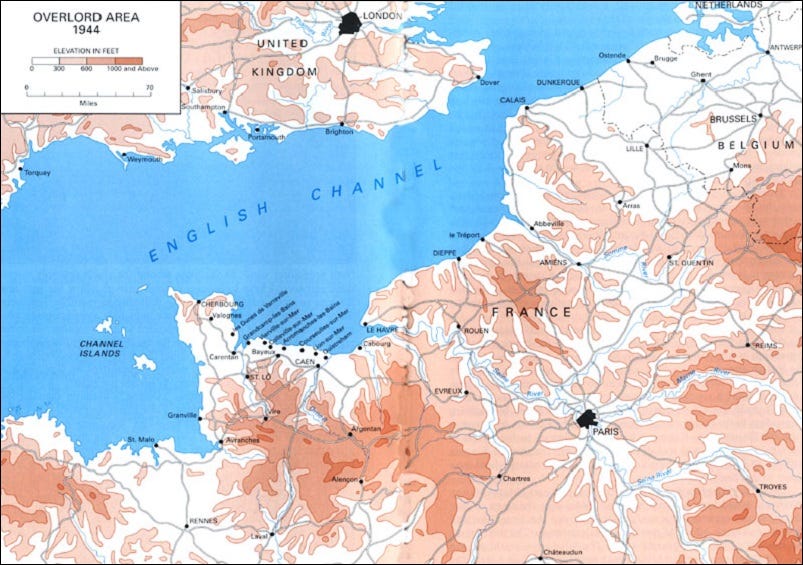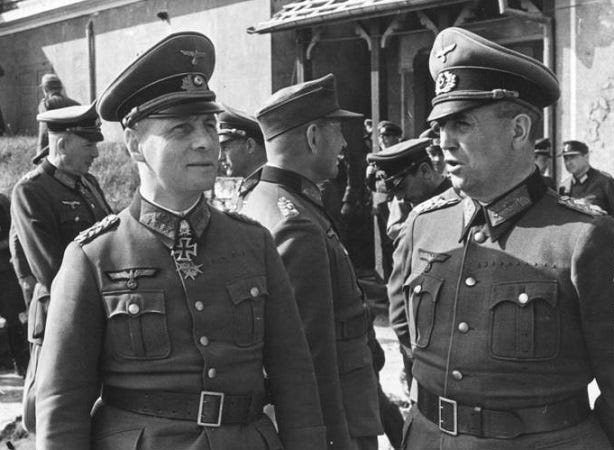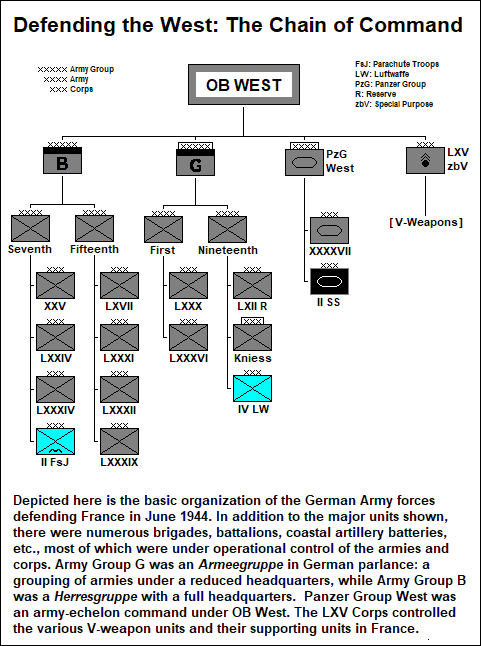PREFATORY NOTE
To commemorate the eightieth anniversary of D-Day and the Battle of Normandy, I am publishing a series of articles on the subject. The present article was published here as part of a series on a possible Chinese invasion of Taiwan; this revised version adds more historical details.
NOTE ON NOMENCLATURE
The German Army's highest field command was the Heeresgruppe (army group). They usually had a geographical designation, e.g. Heeresgruppe Nord (North) or an identifying letter, e.g. Herresgruppe B. Then came the numbered field armies, e.g. 7. Armee (Seventh Army), and panzer armies, e.g. 5. Panzerarmee (Fifth Panzer Army). At the next lower echelon of command were found the Armeekorps (corps), and Panzerkorps (armored corps) which were identified by Roman numerals, e.g. XXVI. Armeekorps, XXXXVII. Panzerkorps. There were also two provisional command arrangements for special missions or emergencies. The Armeeabteilung (army detachment) placed one corps in command of a second corps; the Armeegruppe (army group) was a grouping of field armies under a reduced headquarters. They were usually named after their commander, e.g. Armeeabteilung Kempf, or received a letter designation, e.g. Armeegruppe G.
DEFENDING THE WEST: GERMAN COMMAND AND PLANNING
The German forces tasked to repulse the long-expected Allied invasion of France were under the command of the Oberbefehlshaber West (Commander-in-Chief West)—OB West for short—which also referred to the headquarters as a whole. Since March 1942 this command had been held by Field Marshal Gerd von Rundstedt, the Army’s senior officer, who in June 1944 was sixty-nine years old. OB West had two major formations. Army Group G, which was an Armeegruppe (Colonel-General Johannes Blaskowitz), was responsible for the defense of the Atlantic and Mediterranean coasts of France. Army Group B, which was a Herresgruppe (Field Marshal Erwin Rommel), was responsible for the defense of Brittany and the Channel coast of France and Belgium. An additional headquarters, Panzer Group West (later to become Fifth Panzer Army), controlled three of the six panzer divisions in the Army Group B zone. OB West was answerable to the High Command of the Armed Forces: Oberkommando der Wehrmacht or OKW. In his capacity as supreme commander of the armed forces Hitler issued his orders through OKW, which also served as his planning staff. The High Command of the Army, Oberkommando des Heeres or OKH, was by now restricted to the conduct of operations on the Eastern Front on Hitler’s behalf in his capacity as commander-in-chief of the Army.
If this chain of command seems straightforward, the reality was otherwise. As Rundstedt complained, his authority was circumscribed by Hitler, who was not hesitant to issue orders over the head of OB West. Moreover, neither Rundstedt nor Rommel had full control of the six panzer divisions in the Army Group B zone. The three under Panzer Group West were designated as OKW reserves—meaning that they could not be committed to action without Hitler’s express authorization. This was to have fateful consequences on the day of the invasion.
Since it was considered certain that the invasion, when it came, would strike somewhere between Brittany and Calais, two-thirds of the forces at the disposal of OB West were allotted to Army Group B. The question was precisely where in this area the Allies would land. The obvious spot was the Pas de Calais, where the English Channel was at its narrowest. But there were reasons to think that the enemy might choose Normandy instead. The early seizure of a major port was an obvious Allied objective and Cherbourg at the tip of the Normandy peninsula fitted the bill. And this indeed was a major consideration in the Allies’ choice of Normandy. Hitler himself, though he agreed with his generals that the Pas de Calais was the Allies' most likely target, could not rid himself of the suspicion that they might strike in Normandy instead—an example of the military intuition that the Führer sometimes displayed during the war.
That the Allies would land at the Pas de Calais was no more than an educated guess on the part of the German command. OB West had only the haziest idea of what was happening on the other side of the English Channel. British counterintelligence had long since penetrated the German espionage networks in the United Kingdom, rolling most of them up but turning others and using them to feed bogus information to the enemy. And the Luftwaffe’s ability to conduct air reconnaissance over Britain was all but negated by Allied air superiority.
Two additional factors complicated this guessing game. First, there was Hitler’s anxiety concerning Norway, where he suspected that the Allies might attempt a landing with the objective of barring Germany’s access to Swedish iron ore—essential to industrial production. Second, there was Operation Fortitude, an Allied deception plan designed to convince the Germans that the invasion would come at the Pas de Calais. This involved the creation of a phantom army group in England, supposedly under the command of Lieutenant General George S. Patton. Fake radio traffic, inflatable dummy tanks, guns made of wood and canvas and other deceptions were most successful in convincing German commanders that Pas de Calais was the Allied target. Even on and after 6 June 1944, Rundstedt and others suspected that the Normandy landing was merely a diversion, and that the real invasion had yet to be launched. For that reason, the German command hesitated for some time before transferring troops from Pas de Calais to the Normandy front.
Nor was there unanimity of opinion regarding operational and tactical matters. Rommel, whose task it would be to conduct the defensive battle, believed that it was vital to concentrate all reserves close to the coast, in readiness to meet the invasion on the beaches and throw it back into the sea. If the Allies were not promptly repulsed, he argued, they were unlikely to be driven out at all. Rommel’s experiences during the campaign in North Africa had convinced him that thanks to Allied air superiority, reserves positioned inland would be unable to reach the coast in time to prevent the enemy from consolidating a bridgehead.
But his superior Rundstedt and others at OB West disagreed. Basing themselves on traditional military principles of concentration and mass, they advocated the creation of a powerful panzer reserve, positioned well inland, to deliver a well-planned, carefully prepared counterattack, smashing the invaders in their beachheads before they could build up their strength. The preparation and conduct of this counterattack was to be the mission of Panzer Group West. In the meantime the German infantry divisions, withdrawn out of range of naval gunfire, would dig in and cordon off the invasion zone.
Both sides appealed to Hitler—who characteristically split the difference. Three of the six immediately available panzer divisions were placed under Army Group B. The other three remained with Panzer Group West and were not to be committed to action without OKW approval. In effect, the Führer’s decision approved Rommel’s plan without giving him the forces necessary to do the job. The beaches were sown with mines, strewn with obstacles and covered by artillery. Protected fighting positions for the defending infantry were constructed with interlocking fields of fire. But the panzer divisions, cornerstone of the defense, were not positioned as Rommel desired. On D-Day only one of them, the 21st Panzer Division, was immediately available to launch a counterattack—which failed. And just as the Desert Fox had predicted, the enemy was able to consolidate a bridgehead from which he could not be dislodged.
Whether Rommel or Rundstedt was right in this dispute over operations and tactics is a doubtful question, though with hindsight it appears that Rommel’s assessment of the situation was more realistic. Still, in view of the Allies’ overall superiority of forces, especially in the air, it seems unlikely that the Germans could have repulsed the invasion, whichever plan they adopted. If, however, the commanders on the spot had been given freedom of action, they might well have been able to conduct a fighting retreat to the West Wall, the belt of fortifications along the German frontier, there to make a stand that could have prolonged the war for a long time.
But as it was, Hitler’s failure to deliver a clear-cut decision on defensive tactics and his subsequent refusal to permit any sort of withdrawal were prominent among the factors contributing toward the German Army’s catastrophic defeat in the Battle of Normandy.







My mother is German, so I thought that I had some familiarity with German culture (I speak the language fluently).
Then I ran a German company for a couple of years.
Germans have an almost Byzantine love of bureaucracy and an addiction to org charts that hide the true flow of power. I could only learn the true power structure by being physically on the ground.
Connections outranked titles.
The Nazi regime was the epitome of this national trait.
"it was considered certain that the invasion, when it came, would strike somewhere between Brittany and Calais"
It would be great to have more background on why this was so: it would seem that an equally valid landing spot would be on the Belgian coast between Dunkirk and Holland, where terrain is flat (rather than Normandy's hedgerows) and many Channel ports are available.
I understand the range of the Spitfire was a critical consideration as these were needed over the landing zones but the Dunkirk area is equally valid.
Also, my understanding was that the Germans understood they couldn't stop the landing but hoped to prevent the capture of any ports so that the Autumn gales on the English Channel would then hamper supplies and force the Allies to withdraw.